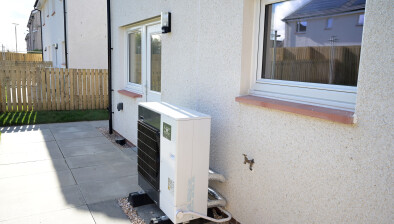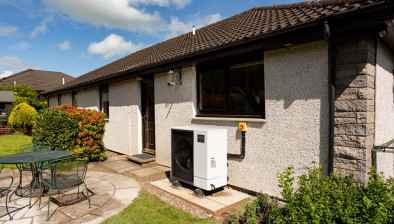New strategy published to transform heating in Scotland’s buildings
Plans to ensure all buildings in Scotland are warmer, more efficient and reach zero emissions by 2045 have been launched for consultation.

The Heat in Buildings strategy sets out the vision for transforming more than 1 million homes and an estimated 50,000 non-domestic buildings to be using low and zero emissions heating systems by 2030 – in line with Scotland’s updated Climate Change Plan - to help meet the world’s toughest emissions reduction target for this date.
The strategy sets out the actions and further proposals that the Scottish Government will take to support the transformation of Scotland’s building stock, which will support thousands of jobs across the sector and wider supply chain.
It also includes plans for engaging people and businesses to ensure everyone across Scotland has an opportunity to shape the transformation, together with proposals for a new regulatory framework which would require the majority of property owners to take action over time to install energy efficiency measures and zero emission heating systems.
The strategy outlines the crucial action needed from the UK Government to enable faster deployment of zero emissions heating in Scotland, including taking early decisions on the future of the gas network and increasing funding for UK-wide delivery schemes.
The Scottish Government is committed to ground-breaking levels of investment of £1.6 billion over the next five years to help transform the heating and energy efficiency performance of Scotland’s buildings. This will rapidly accelerate the installation of energy efficiency measures and zero emissions heating systems to decarbonise an area which currently is responsible for creating one fifth of Scotland’s greenhouse gas emissions each year. The investment, outlined in the current Programme for Government, is anticipated to support up to 5,000 jobs each year by 2025-26, with further growth beyond that date.
Launching a consultation on the proposals, Scotland’s energy minister, Paul Wheelhouse, said: “Reducing greenhouse gas emissions arising from heating our homes and buildings is one of the most important things we can do to help end Scotland’s contribution to climate change, given that heating accounts for more than half the energy we consume as a society.
“We are therefore committed to rapidly scaling-up action on decarbonising heating, but doing so in a way that ensures that our fuel poverty objectives and our commitment to tackling climate change work together, ensuring a fair and just transition to net zero emissions. This strategy must play a part in helping everyone to have a warm home that supports their good health and wellbeing.
“The draft strategy sets out our vision to achieving this and actions that we will take using the Scottish Parliament’s powers, while also demonstrating just how critical it is that the UK Government takes further action, and faster action, in areas of policy it controls if we are to achieve our respective net-zero ambitions.
“The changes needed to make our homes and buildings fit for a net-zero future, and to help avoid potentially serious damage to our climate for current and future generations of Scots, will touch on all our lives and are likely to require us all to take action. It is therefore only right that everyone in Scotland has an opportunity to feed in and shape our Heat in Buildings Strategy and I would urge everyone to take part in our consultation.”
The Existing Homes Alliance Scotland has welcomed the draft strategy for setting “a pathway to net-zero homes and tackling fuel poverty” but called for a budget to achieve those goals. The Alliance particularly welcomed the aim for over one million homes to be highly energy efficient and zero emissions from heat by 2030.
Chair Lori McElroy said: “We are delighted that the Scottish Government recognises the fundamental role that energy efficiency plays in reducing the potential investment and running costs associated with the transition to low carbon heat.
“There is a real focus on people in this strategy - ensuring no-one is left behind and that we maximise the jobs benefits, and this should be commended.
“We are pleased to see a commitment to a new regulatory framework that will help to give clarity and certainty to homeowners, landlords and supply chains.”
Adding a note of caution, Lori McElroy added: “However, if we are to make the rapid progress needed over the early part of this next decade, we must make sure the resources balance the ambition, which is why we are calling for a doubling of the funding for existing fuel poverty and energy efficiency programmes.
“This draft strategy is a welcome and positive step on our journey to net zero. We look forward to studying it in more detail and working with the Scottish Government to develop a framework that delivers on these ambitions.”
Helen Melone, policy manager at Scottish Renewables, said: “While we are pleased that The Scottish Government has published its draft Heat in Buildings Strategy, setting out how it is going to reduce emissions from heating and buildings, help to end Scotland’s contribution to climate change and support up to 24,000 jobs each year, the sums which it commits to the process fall far short of those required for the task.
“Homes and workplaces account for a fifth of Scotland’s total greenhouse gas emissions, and heating accounts for more than half of Scotland’s energy use. Currently, however, only 6.5% of Scotland’s are met from low-carbon and renewable sources.
“It is important that a long-term plan for net-zero is realistic about the cost of our ambitions. While The Scottish Government’s intention to convert one million homes and around 50,000 non-domestic buildings to zero-emission heating systems by 2030 – made today - is welcome, we must be clear that the cost of doing so will require in excess of the £1.6 billion investment announced today. In fact, The Scottish Government’s own estimate is that converting our building stock to zero emissions by 2045 will require a total investment of £33bn.
“What this draft Heat in Buildings Strategy does do is set out a clear direction of planned actions and proposals which will help industry plan for the future. It provides the longer-term policy certainty which businesses need to ensure that the supply chains and skills we’ll need to meet net-zero can develop as we accelerate on the journey to a truly low-carbon energy system.”
Fabrice Leveque, head of policy at WWF Scotland, said: “It’s great to see this comprehensive plan that shows how Scotland will get to grips with one of the biggest challenges in reaching net-zero climate emissions – how we heat our buildings. There are many welcome steps, including the phasing out of public funding for fossil fuel heating systems, though this needs to go faster, and targets to increase the use of heat networks across the country. These steps are needed to accelerate the climate make-over that our homes and buildings require, which is also an opportunity to create healthier homes and new economic opportunities as part of a green recovery.
“However, there are missed opportunities including the failure to increase funding for fuel poverty schemes despite the economic boost that this could bring, and that the date for bringing homes up to a good standard of energy performance is still too far away at 2035.”
Citizens Advice Scotland (CAS) said the new strategy must benefit consumers as well as the environment.
Heat demand currently accounts for 50.7% of Scotland’s total energy consumption and so the strategy, which sets out the Scottish Government’s plans for improving energy efficiency and decarbonising heat in all buildings in Scotland, will play an essential role in the transition to a net zero emissions society whilst also tackling fuel poverty.
CAS energy spokesperson Kate Morrison said: “Decarbonising heat is perhaps the most significant infrastructure challenge Scotland will face over the next 25 years. Achieving this in a way that benefits consumers and reduces fuel poverty will be vital to a just transition. We’re therefore pleased that the Scottish Government has recognised the central role of individuals in the delivery of this strategy. That the government also outlines the need to link the decarbonisation of heat with efforts to reduce fuel poverty is particularly welcome.
“Today’s strategy clarifies the standards the government expects all buildings in Scotland to achieve. However, realising this ambition will be a big ask of many stakeholders, including landlords, home owners and local authorities. It will therefore be essential that sufficient resources are allocated to support partners to successfully deliver this Strategy. With this in mind, we hope to see an increase in public energy efficiency investment in the Budget that reflects the scale of the commitments outlined in this strategy.
“CAS is a strong advocate of a ‘fabric first’ approach to the decarbonisation of heat. Failing to make buildings as energy efficient as possible before or alongside the installation of low carbon heating risks outcomes that do not benefit the occupier, and could exacerbate already worrying levels of fuel poverty in Scotland.
“It is vital that clear, timely guidance is issued to enable people to make informed decisions in line with the Strategy. This must be complimented by a robust consumer protection framework to protect the public as more and more becomes expected of them.
“There is a shared responsibility across the industry and its stakeholders to ensure that plans are implemented in line with the principles of ethical business practice, and we look forward to working in collaboration with partners in industry and Government to continue to make the case for this ambition.”








